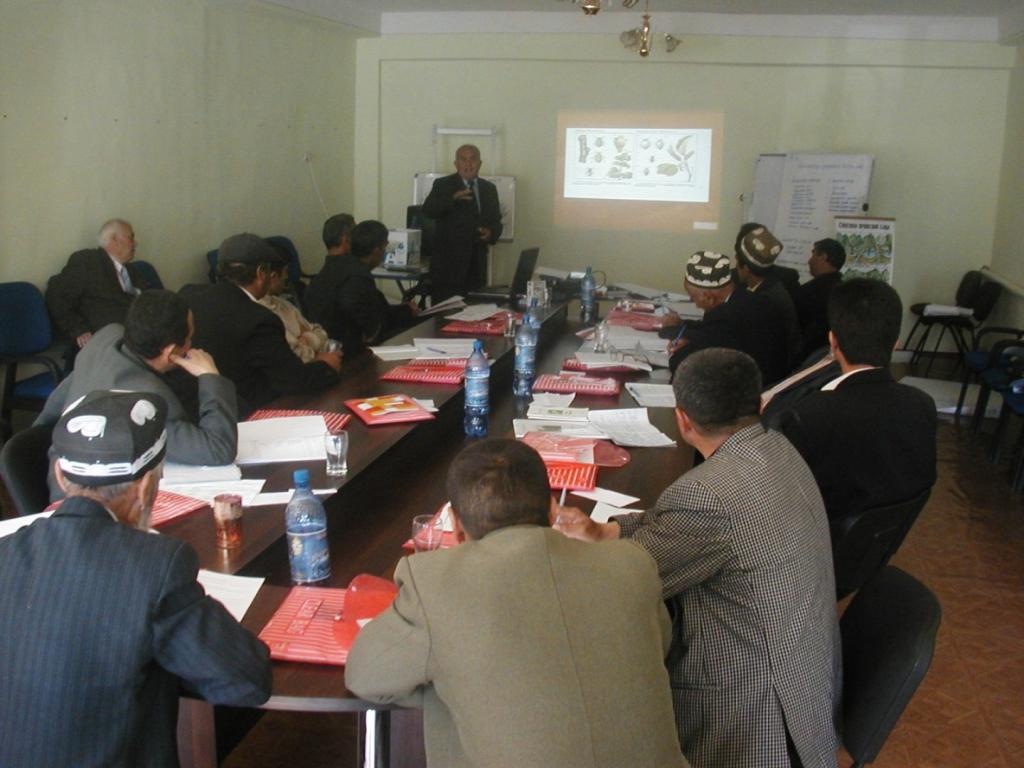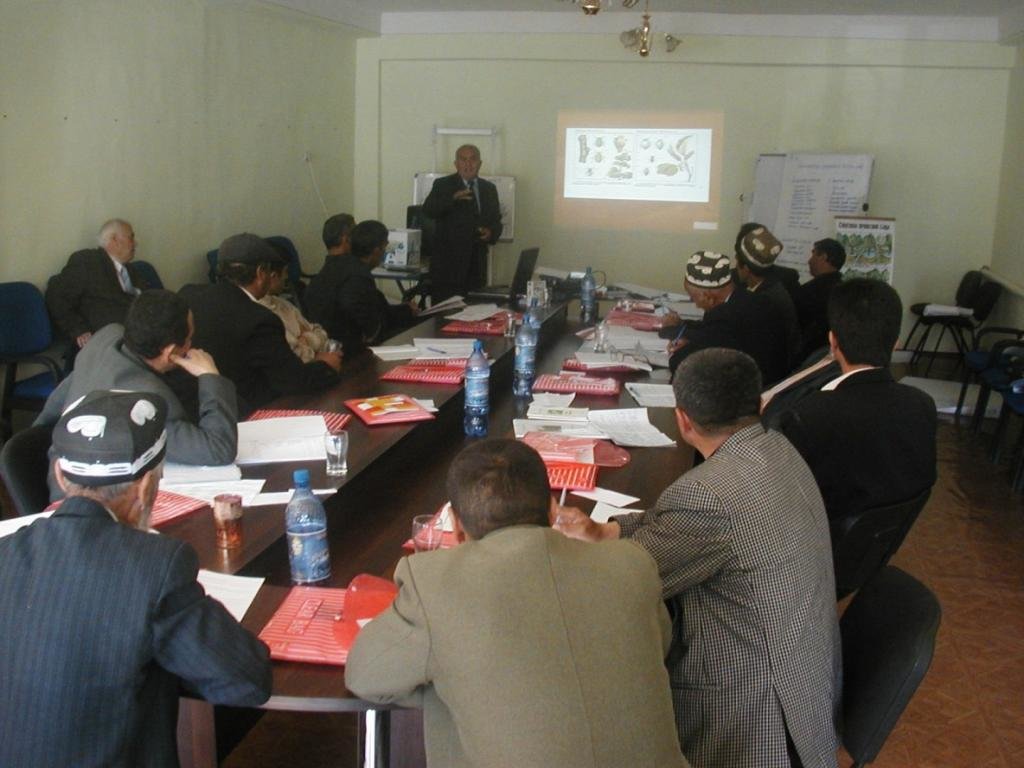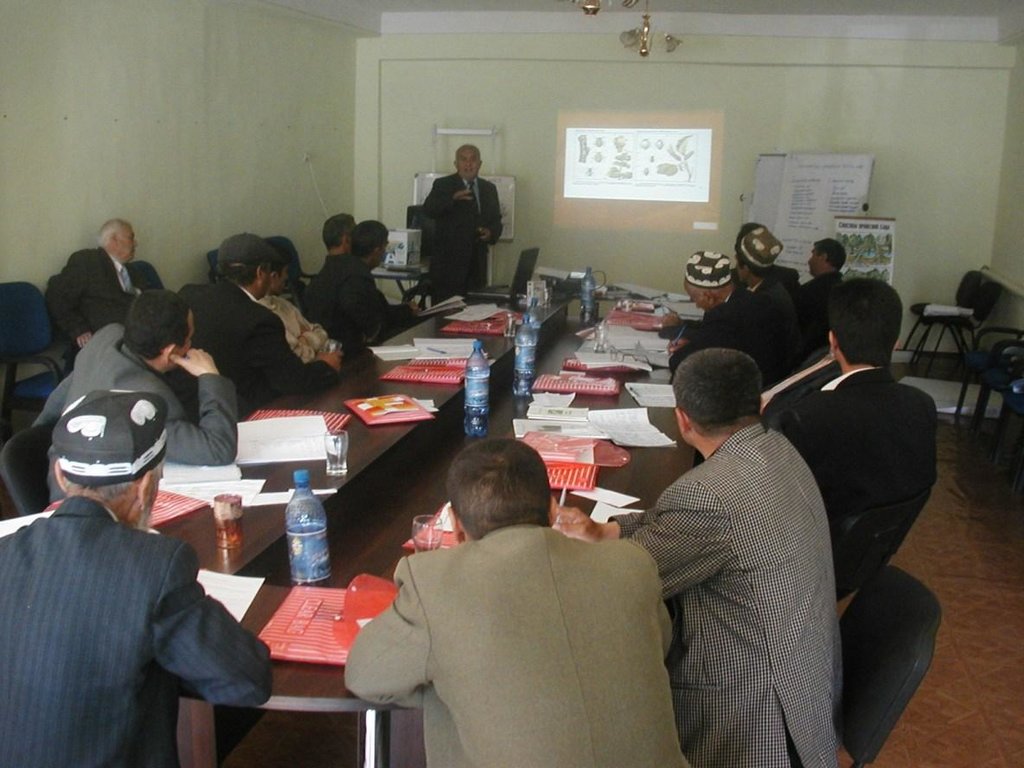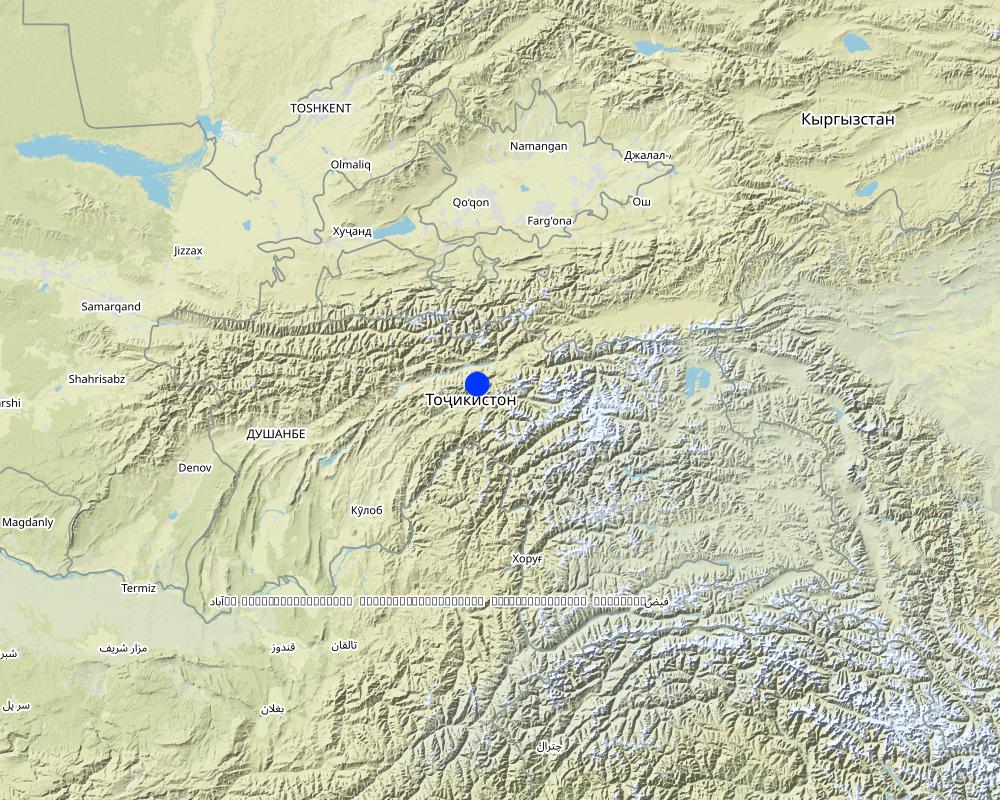Facilitation of community-based pasture management initiatives [ทาจิกิสถาน]
- ผู้สร้างสรรค์:
- การอัพเดท:
- ผู้รวบรวม: Mizrob Amirbekov
- ผู้เรียบเรียง: –
- ผู้ตรวจสอบ: David Streiff, Alexandra Gavilano, Joana Eichenberger
Mountain Societies Development Support Programme - Aga Khan Foundation
approaches_2444 - ทาจิกิสถาน
ดูส่วนย่อย
ขยายทั้งหมด ย่อทั้งหมด1. ข้อมูลทั่วไป
1.2 รายละเอียดที่ติดต่อได้ของผู้รวบรวมและองค์กรที่เกี่ยวข้องในการประเมินและการจัดเตรียมทำเอกสารของแนวทาง
ผู้เชี่ยวชาญ SLM:
Pachova Nevelina
Palm
ชื่อของโครงการซึ่งอำนวยความสะดวกในการทำเอกสารหรือการประเมินแนวทาง (ถ้าเกี่ยวข้อง)
Sustainable Land Management in the High Pamir and Pamir-Alai Mountains (PALM Project / NCCR)ชื่อของโครงการซึ่งอำนวยความสะดวกในการทำเอกสารหรือการประเมินแนวทาง (ถ้าเกี่ยวข้อง)
Pilot Program for Climate Resilience, Tajikistan (WB / PPCR)ชื่อของโครงการซึ่งอำนวยความสะดวกในการทำเอกสารหรือการประเมินแนวทาง (ถ้าเกี่ยวข้อง)
Kyrgyzstan Mountain Societies Development Support Programme, Aga Khan Development Network (MSDSP KG) - คีร์กีซสถาน1.3 เงื่อนไขที่เกี่ยวข้องกับการใช้ข้อมูลที่ได้บันทึกไว้ผ่านทาง WOCAT
ผู้รวบรวมและวิทยากรหลักยอมรับเงื่อนไขเกี่ยวกับการใช้ข้อมูลที่ถูกบันทึกผ่านทาง WOCAT:
ใช่
2. คำอธิบายของแนวทาง SLM
2.1 การอธิบายแบบสั้น ๆ ของแนวทาง
Initiation of community-based solutions to slow down pasture degradation, and to improve pasture use and management in three pilot Jamoats of upland Tajikistan.
2.2 การอธิบายอย่างละเอียดของแนวทาง
การอธิบายอย่างละเอียดของแนวทาง:
Aims / objectives: During the Soviet times land users in Tajikistan were allowed to keep very little livestock individually and this was mainly in the vicinity of rural settlements. The majority of the livestock were managed by collective agricultural farms, which utilised different seasonal pastures. After the collapse of the Soviet Union, the previously state-owned livestock was distributed among individual farmers, most of whom had limited knowledge and experience with pasture management (PM), and capacities to access the distant pastures used by the collective farms. As a consequence, the amount of livestock kept in the vicinity of rural settlements increased, leading to overgrazing and severe degradation of nearby pastures. In the framework of a project on sustainable land management in the Pamir-Alai region (PALM), funded by the Global Environment Facility (GEF), MSDSP facilitated the initiation of community-based solutions to the problem of pasture degradation at three pilot jamoats in Jirgital, and three in Gorno-Badakhshan Autonomous Oblast (GBAO).
Methods: 1. Awareness raising and capacity building of PM issues. 2. Integration of PM issues in village development plans. 3. Grant support and community co-financing for implementation of targeted measures. 4. Monitoring of the impacts of the implemented measures as a basis for up-scaling.
Stages of implementation: 1. National pasture management experts from the Pamir Biological Institute held a training of trainers (ToT) session for MSDSP facilitators and district specialists, who conducted follow-up training on PM at the pilot communities in 2009. 2. Pilot communities identified key problems related to PM in the process of Village Development Planning facilitated by MSDSP, and prioritised targeted measures for improved PM. 3. A set of micro-project proposals were developed based on the prioritised measures, which focused on (re-) construction of roads and bridges for improved access to pastures, and construction of stables during spring/autumn, as well as summer pastures. 4. Monitoring of the impacts of the implemented measures as a basis for up-scaling.
Role of stakeholders: Community members were engaged in identifying and implementing targeted measures for addressing pasture use and management issues. Jamoat level non-governmental organisations called Social Unions for Development of Village Organizations (SUDVOs), coordinated and supported the identification and implementation of the selected projects in several village organisations. Governmental agricultural extension agents were engaged in training, and consulted in the review process. MSDSP staff facilitated the overall process and engaged in monitoring progress with implementation. PALM project staff engaged in the review, monitoring and assessment of the impacts of the supported measures.
2.3 รูปภาพของแนวทาง
2.5 ประเทศ ภูมิภาค หรือสถานที่ตั้งที่ได้นำแนวทางไปใช้
ประเทศ:
ทาจิกิสถาน
ข้อมูลเฉพาะเพิ่มเติมของสถานที่ตั้ง:
Jirgatol
ความคิดเห็น:
Three pilot jamoats in the Jirgital region (Jirgital, Pildon and Yangishar), and three in Gorno-Badakhshan Autonomous Oblast (GBAO), (Shitharv, Vankala and Alichur) were covered by the approach
Map
×2.6 วันที่เริ่มต้นและสิ้นสุดของแนวทาง
ระบุปีที่เริ่ม:
2009
2.7 ประเภทของแนวทาง
- ใช้โครงงานหรือแผนงานเป็นฐาน
2.8 เป้าหมายหรือวัตถุประสงค์หลักของแนวทาง
The Approach focused mainly on SLM with other activities (rehabilitation of rural infrastructure to improve access to pastures, pasture and livestock productivity, animal diseases)
The main aim of the approach was to initiate the improved use and management of pastures, by raising awareness and knowledge on issues regarding pasture degradation and sustainable pasture management, mobilising community action, and pilot-testing selected technologies and measures for improving pasture management in highly degraded areas.
The SLM Approach addressed the following problems: pasture degradation, overgrazing, restricted pasture area and too many cattle garzing, lack of infrastructure (bridges, roads, shelters), lack of knowledge about pasture management
2.9 เงื่อนไขที่เอื้ออำนวยหรือเป็นอุปสรรคต่อการนำเทคโนโลยีภายใต้แนวทางนี้ไปปฏิบัติใช้
การมีไว้ให้หรือการเข้าถึงแหล่งการเงินและบริการ
- เป็นอุปสรรค
communities were lacking funds for infrastructure development and could therefore not invest in the construction of roads and bridges
Treatment through the SLM Approach: GEF funds were used to support communities in financing infrastructural improvements which allowed for more productive and sustainable use of available pasture resources
การจัดตั้งระดับองค์กร
- เป็นอุปสรรค
Lack of capacity to deal with pasture degradation problems
Treatment through the SLM Approach: Engagement of village organisations, and social unions of village organisations (SUDVO) in addressing pasture management issues at six pilot jamoats
กรอบแนวทางในการดำเนินการด้านกฎหมาย (การถือครองที่ดิน สิทธิในการใช้ที่ดินและน้ำ)
- เป็นอุปสรรค
Limited clarity regarding responsibilities and lack of incentives for sustainable pasture management
Treatment through the SLM Approach: MSDSP and PALM project members recommended the development of a pasture management law that addresses those legal constrains
The existing land ownership, land use rights / water rights moderately hindered the approach implementation there is no law about pasture management in Tajikistan, therefore it was difficult to regulate the process
ความรู้เกี่ยวกับ SLM การเข้าถึงการสนับสนุนด้านเทคนิค
- เป็นอุปสรรค
technical knowledge about pasture management was lacking as during Soviet times people were not allowed to keep a lot of livestock
Treatment through the SLM Approach: Community members of village organisations and relevant government experts were trained in various issues of pasture management
3. การมีส่วนร่วมและบทบาทของผู้มีส่วนได้ส่วนเสียที่เกี่ยวข้อง
3.1 ผู้มีส่วนได้ส่วนเสียที่เกี่ยวข้องในแนวทางนี้และบทบาท
- ผู้ใช้ที่ดินระดับท้องถิ่นหรือชุมชนระดับท้องถิ่น
Village organisations
Only 20% of the participants were women, since men are responsible for managing the livestock, while women are concerned with livestock products only
Elderly members of the communities were engaged in discussions on the possible solutions
- ผู้เชี่ยวชาญ SLM หรือที่ปรึกษาการเกษตร
Governmental agricultural advisors participated in the training.
- รัฐบาลแห่งชาติ (ผู้วางแผน ผู้ทำการตัดสินใจ)
Agrarian University in Jirgatol, Pamir Biological Institute
- pilot communities
3.2 การเกี่ยวข้องของผู้ใช้ที่ดินระดับท้องถิ่นหรือชุมชนระดับท้องถิ่นในช่วงต่างๆของแนวทาง
| ความเกี่ยวข้องของผู้ใช้ที่ดินระดับท้องถิ่นหรือชุมชนระดับท้องถิ่น | ระบุผู้ที่มีส่วนเกี่ยวข้องและอธิบายกิจกรรม | |
|---|---|---|
| การริเริ่มหรือการจูงใจ | ไม่มี | |
| การวางแผน | ปฏิสัมพันธ์ | Members of village organisations were involved in training and planning on pasture management, and actively participated in discussions |
| การดำเนินการ | ระดมกำลังด้วยตนเอง | The village organisations developed their own project ideas and submitted those proposals to MSDSP and other funders |
| การติดตามตรวจสอบหรือการประเมินผล | ปฏิสัมพันธ์ | Land users were engaged in the monitoring and evaluation of the impacts of the implemented projects |
| Research | ปฏิสัมพันธ์ | The Pamir-Biological Institute and the Institute of Botany under the Academy of Sciences were engaged in research and technical consultations |
3.4 การตัดสินใจเลือกใช้เทคโนโลยี SLM
ระบุผู้ที่ทำการตัดสินใจเลือกเทคโนโลยีมากกว่าหนึ่งวิธีไปปฏิบัติใช้:
- pilot communities
การอธิบาย:
Community members were engaged in identifying and implementing targeted measures for addressing pasture use and management issues.
Decisions on the method of implementing the SLM Technology were made by pilot communities and facilitators. Community members were engaged in identifying and implementing targeted measures for addressing pasture use and management issues.
4. การสนับสนุนด้านเทคนิค การสร้างขีดความสามารถ และการจัดการด้านความรู้
4.1 การสร้างขีดความสามารถ / การอบรม
ได้มีการจัดอบรมให้แก่ผู้ใช้ที่ดินหรือผู้มีส่วนได้ส่วนเสียคนอื่น ๆ หรือไม่:
ใช่
ให้ระบุว่าใครเป็นผู้ได้รับการอบรม:
- ผู้ใช้ที่ดิน
- เจ้าหน้าที่ภาคสนาม / ที่ปรึกษา
รูปแบบการอบรม:
- จัดคอร์ส
หัวข้อที่พูด:
Short training courses were provided for land user, field staff/agricultural advisors
4.2 การบริการให้คำแนะนำ
ผู้ใช้ที่ดินมีการเข้าถึงการรับบริการให้คำปรึกษาหรือไม่:
ใช่
- through trained experts
การอธิบาย/แสดงความคิดเห็น:
Name of method used for advisory service: Engineering support and technical consultations
Advisory service is quite adequate to ensure the continuation of land conservation activities
4.3 การเสริมความแข็งแกร่งให้กับสถาบัน (การพัฒนาองค์กร)
สถาบันได้รับการจัดตั้งขึ้นมาหรือเสริมความแข็งแกร่งโดยแนวทางนี้หรือไม่:
- ใช่ อย่างมาก
ระบุระดับของสถาบันที่ได้รับการเสริมความแข็งแกร่งหรือจัดตั้งขึ้นมา:
- ท้องถิ่น
ระบุประเภทของการให้ความช่วยเหลือสนับสนุน:
- การสร้างขีดความสามารถ / การอบรม
ให้รายละเอียดเพิ่มเติม :
village organisations were trained
4.4 การติดตามตรวจสอบและประเมินผล
การติดตามตรวจสอบและประเมินผลเป็นส่วนหนึ่งของแนวทางหรือไม่:
ใช่
ความคิดเห็น:
economic / production aspects were regular monitored by project staff through observations; indicators: changes in economic benefits for households before and after implementation of project
bio-physical aspects were regular monitored by project staff through observations; indicators: changes in vegetation coverage, edible grass species, etc.
area treated aspects were regular monitored by project staff through observations; indicators: Established at the start of project implementation
There were several changes in the Approach as a result of monitoring and evaluation: Some areas were grazed although they should not have been, project staff then talked to the responsible people in the village to ask about the causes for this and to try and initiate changes in practice.
4.5 การวิจัย
การวิจัยเป็นส่วนหนึ่งของแนวทางหรือไม่:
ใช่
- pasture management
ให้ข้อมูลเพิ่มเติมและให้ระบุผู้ทำการวิจัย:
Aimed at problem, option and impact assessment
Research was carried out on-farm
5. การสนับสนุนด้านการเงินและวัสดุอุปกรณ์
5.1 ระบุงบประมาณประจำปีสำหรับแนวทาง SLM นี้
ถ้าหากว่างบประมาณประจำปีไม่เป็นที่ทราบแน่นอน ให้ระบุช่วงลงไป:
- 2,000-10,000
แสดงความคิดเห็น (แหล่งของการระดมทุน ผู้บริจาคคนสำคัญ):
Approach costs were met by the following donors: international (PALM): 70.0%; national non-government (MSDSP): 30.0%
5.2 การสนับสนุนด้านการเงิน / วัสดุอุปกรณ์ให้แก่ผู้ใช้ที่ดิน
ผู้ใช้ที่ดินได้รับการสนับสนุนด้านการเงิน / วัสดุอุปกรณ์ไปปฏิบัติใช้เทคโนโลยีหรือไม่:
ไม่ใช่
5.3 เงินสนับสนุนสำหรับปัจจัยนำเข้า (รวมถึงแรงงาน)
- โครงสร้างพื้นฐาน
| ระบุปัจจัยนำเข้าที่ได้รับการสนับสนุน | เห็นด้วยระดับไหน | ระบุเงินสนับสนุน |
|---|---|---|
| ถนน | ได้รับการช่วยเหลือทางการเงินบางส่วน | |
| bridges, shelters | ได้รับการช่วยเหลือทางการเงินบางส่วน | |
ถ้าแรงงานโดยผู้ใช้ที่ดินเป็นปัจจัยนำเข้าที่มีอยู่มากมาย ระบุด้วยว่าเนื่องจาก:
- สมัครใจ
5.4 เครดิต
มีการจัดหาเครดิตมาให้ภายใต้แนวทาง SLM หรือไม่:
ไม่ใช่
6. การวิเคราะห์ผลกระทบและการสรุป
6.1 ผลกระทบของแนวทาง
ช่วยให้ผู้ใช้ที่ดินนำเอาเทคโนโลยี SLMไปใช้และบำรุงรักษาสภาพไว้ได้หรือไม่:
- ไม่ใช่
- ใช่ เล็กน้อย
- ใช่ ปานกลาง
- ใช่ อย่างมาก
Reduced pressures on pastures in the vicinity of rural settlements
ทำให้กลุ่มด้อยโอกาสมีอำนาจทางสังคมและเศรษฐกิจหรือไม่:
- ไม่ใช่
- ใช่ เล็กน้อย
- ใช่ ปานกลาง
- ใช่ อย่างมาก
Elderly herders with improved access to health facilities
ปรับปรุงประเด็นของการถือครองที่ดินหรือสิทธิในการใช้ ซึ่งขัดขวางการนำเทคโนโลยีไปใช้ให้ดีขึ้น:
- ไม่ใช่
- ใช่ เล็กน้อย
- ใช่ ปานกลาง
- ใช่ อย่างมาก
talks with the government were started to make way for a law on pasture management
Did other land users / projects adopt the Approach?
- ไม่ใช่
- ใช่ เล็กน้อย
- ใช่ ปานกลาง
- ใช่ อย่างมาก
Strong interest by other communities but limited financial means for replication
Did the Approach lead to improved livelihoods / human well-being?
- ไม่ใช่
- ใช่ เล็กน้อย
- ใช่ ปานกลาง
- ใช่ อย่างมาก
Improved access to fodder, reduced loss of livestock, etc
Did the Approach help to alleviate poverty?
- ไม่ใช่
- ใช่ เล็กน้อย
- ใช่ ปานกลาง
- ใช่ อย่างมาก
The primary beneficiaries are the groups with a medium income
6.2 แรงจูงใจหลักของผู้ใช้ที่ดินเพื่อที่จะนำ SLM ไปปฏิบัติใช้
- การผลิตที่เพิ่มขึ้น
Increased pasture area and livestock productivity, reduced loss of livestock, reduced labour inputs
- จิตสำนึกด้านสิ่งแวดล้อม
Increased awareness of the degradation of pastures
- well-being and livelihoods improvement
Improved convenience, reduced conflicts over livestock tramping and grazing of croplands
6.3 ความยั่งยืนของกิจกรรมของแนวทาง
ผู้ใช้ที่ดินสามารถทำให้สิ่งต่างๆ ที่ได้ปฏิบัติใช้โดยแนวทางนี้ยั่งยืนได้หรือไม่ (โดยไม่มีการสนับสนุนจากภายนอก):
- ใช่
ถ้าตอบว่าใช่ ให้อธิบายว่าอย่างไร :
The village organisations have the responsibility to teach their community members
6.4 จุดแข็งและข้อได้เปรียบของแนวทาง
| จุดแข็ง / ข้อได้เปรียบของแนวทางในทัศนคติของผู้รวบรวมหรือวิทยากรหลัก |
|---|
| Reduction of conflicts over resource use and strengthened social capital (How to sustain/ enhance this strength: utilise the improved social capital for addressing other pressing environmental and community development issues) |
| Improved income from livestock provides a strong incentive for sustaining the established infrastructure (How to sustain/ enhance this strength: a proportion of the obtained income should be reinvested in maintenance e.g. through collection of user fees ) |
| Improved environmental conditions in the vicinity of rural settlements, and reduced labour inputs into livestock breeding (How to sustain/ enhance this strength: capitalise on those environmental improvements through the development of alternative income-generating activities such as bee-keeping and eco-tourism that will limit the need for further increases in livestock numbers) |
6.5 จุดอ่อน / ข้อเสียเปรียบของแนวทางและวิธีในการแก้ไข
| จุดอ่อน / ข้อเสียเปรียบในทัศนคติของผู้รวบรวมหรือวิทยากรหลัก | สามารถแก้ไขปัญหาได้อย่างไร |
|---|---|
| Improved access to new pastures and possible further increases in livestock numbers may lead to their degradation in the future | Community members and village organisations have to make sure that the new pastures are being used in a sustainable manner e.g. through controlled grazing and pasture rotation, designation of no-grazing areas in pristine forests in the vicinity of new pastures, etc. |
| The approach contributes to improve the well-being of the medium income groups of the communities in question, as accessing distant pastures is most often not a problem for the better-off, while the poor often have only limited or no livestock | use as part of the generated additional income in the community for support of poor households |
| The approach is economically beneficial but difficult to up-scale due to the high initial investment costs | identify appropriate mechanisms for stimulating replication through relevant legal and policy incentives or alternative financing |
7. การอ้างอิงและการเชื่อมต่อ
7.1 วิธีการหรือแหล่งข้อมูล
- ไปเยี่ยมชมภาคสนาม การสำรวจพื้นที่ภาคสนาม
- การสัมภาษณ์กับผู้ใช้ที่ดิน
ลิงก์และโมดูล
ขยายทั้งหมด ย่อทั้งหมดลิงก์
ไม่มีลิงก์
โมดูล
ไม่มีโมดูล





